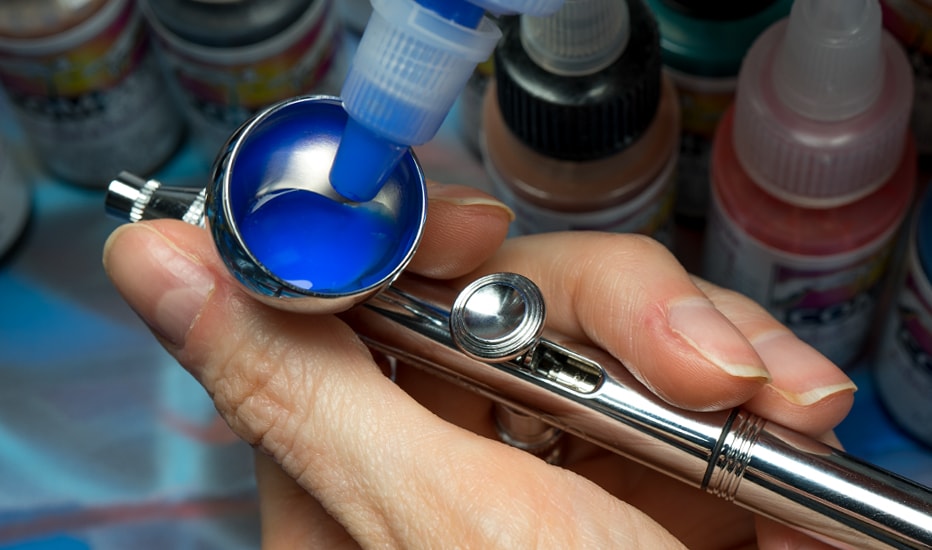16 January 2020
|
What’s so special about the airbrush then? When it comes to applying paint to any surface, flat or contoured, airbrushes really are special. Every other method of traditional painting uses a brush or some kind of applicator - how else are you going to get that paint from the tube or bottle onto your prized work? The thing is the applicator leaves its fingerprints all over your work such as brush marks here and there. Of course, if you are going for a brushed look this may add some character to your models!
But what about artists and modellers who want the PERFECT finish? The airbrush atomises the paint into tiny droplets, allowing you to lay down colours really gently and with a lot less overspray. You can achieve ultra-fine detail as well as getting those base layers down much more evenly. With more control you can create effects that you could never achieve with a paint brush or spray can.
Need help choosing an airbrush? Check out this useful page at Airbrushes.com Read Here

Expert, tutor and commissioned artist Myles David says:
“The airbrush is becoming an essential tool in the arsenal of miniature painters. From pre-shading, plotting light and shadow placement, to finishing techniques like weathering, the airbrush does it all. Some challenging effects like realistic chipping are made easy by the even, consistent coverage an airbrush allows.
We are seeing higher end airbrushes make their way into miniature painting - to finish miniatures rather than establish a base coat. It’s fascinating to see the evolution of this tool in our hobby and how versatile it is.”
Myles,
Lil’Legend Commission Painting Studio
www.patreon.com/lillegendstudio


Airbrushing tips from The Airbrush Company Ltd:
Paint Consistency:
Any fluid can be sprayed through an airbrush providing you can thin it to a milky consistency, which is the general rule-of-thumb. Within this rule, the viscosity may range from that of skimmed milk, through to semi-skimmed up to creamy milk, which will depend on the paint you use. If you are spraying thicker paints, you will require a larger nozzle size, e.g. airbrushes with the largest 0.5mm nozzle and needle set up.
A simple way to check the consistency is to drag a little paint from the bottom of the airbrush cup up to the edges, if the paint runs down without leaving a trace, then you’re good. If the paint is too thick it will stick to the cup or move down very slowly and leave a trace of paint – add water or airbrush thinner until its right for you.
Airbrushes.com offer a wide range of airbrush paints for modelling: Here

Air Pressure:
When painting miniatures we want a PSI reading (pounds per square inch) of around 12-18 for pre-thinned paint. Thicker paint will most likely require that little bit more pressure.
Need help choosing a compressor? Read Here for expert advice.
Priming:
A coat of primer provides a consistent base for the paints that follow, as well as assisting the paint to adhere to the model. If your model comprises different colours of plastic, metal, or resin then a coat of primer will provide a uniform base. For colours that typically present coverage issues (such as white, yellow, or red), primer also helps to reduce the number of coats needed. Priming the model has the additional advantage of revealing construction flaws, gaps or seams before any finishing coats are applied.

Cleaning:
Keeping your airbrush clean is essential. The vast majority of airbrush problems occur because the airbrush is simply blocked, or has seized up through lack of regular, thorough cleaning. You need to clean your airbrush between every colour change, as well as giving it an extra-thorough clean at the end of the session. For a thorough clean, first flush the airbrush with water to remove the worst of the colour. Follow with a proper airbrush cleaning fluid and then do a final flush with water. Do not allow the paint to sit in the airbrush for longer than necessary.

Check out this Airbrush Operation & Cleaning Guide: Operation & Cleaning Guide
Where to buy from:
The Airbrush Co Ltd has more than 70 years’ experience in airbrushing and selling specialised airbrush equipment in the UK and all over the world. We do have a great website (www.airbrushes.com) that you can visit, but we are more than just an online seller, we have humans here you can speak to on the phone to discuss airbrush types, paints, troubleshooting, anything really. Just give us a call on 01903 767800 or email sales@airbrushes.com.








